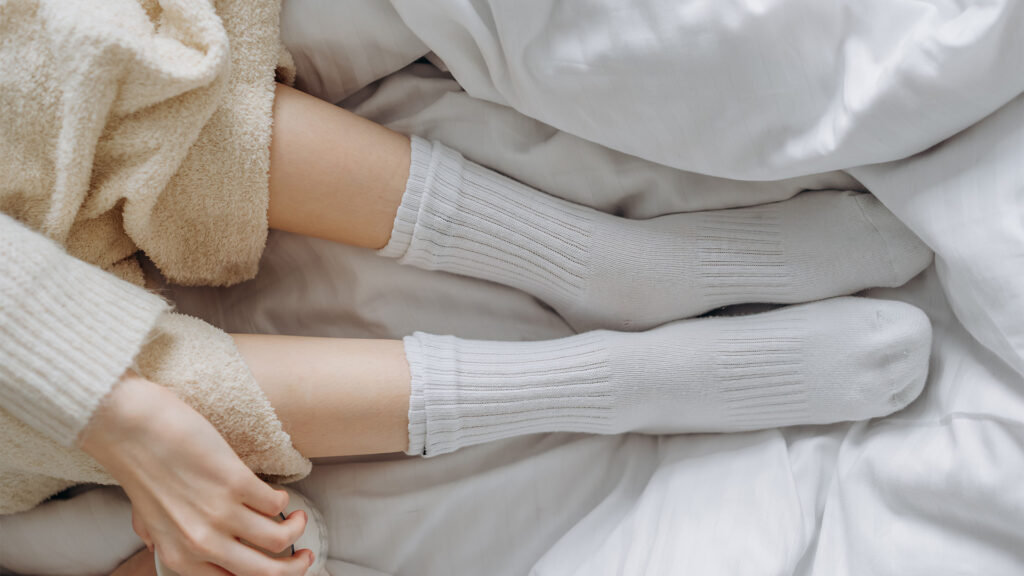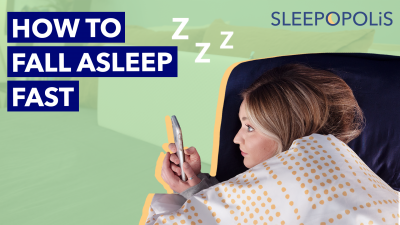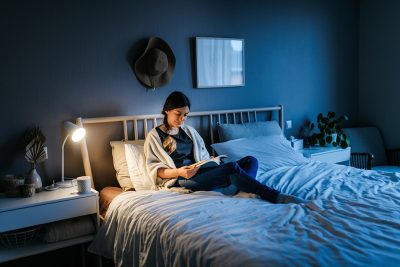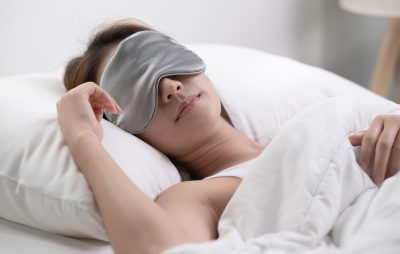Table of Contents

When a good night’s rest is elusive, we’ll sometimes try just about anything to get back on track. Meditation. Warm milk. Even “pillow manifestation” may be a snoozing solution in the short term. It’s also possible that sleeping with socks on may be a simple, reliable method to resolve numerous issues that create barriers to our slumber.
Dr. Timothy J. Miller of Sunshine Ankle & Foot Experts in Orlando tells Sleepopolis that we sleep better if our feet are comfortable and relaxed. So here are some reasons why slipping your toes into socks before bedtime is helpful — and when you’re better off barefooted.
Long Story Short
- Sleeping with socks on may help you regulate your body temperature and help you fall asleep faster.
- Wearing socks helps warm your feet, which increases circulation.
- Before slipping socks on your child at bedtime, consult their pediatrician.
Can Sleeping With Socks Make Me Fall Asleep Faster?
Possibly. Proper room temperature (somewhere between 60 and 67 degrees Fahrenheit is the sweet spot) and body thermoregulation may be essential factors for achieving a good night’s sleep. But what may surprise you is that our poor, beleaguered feet sometimes need some TLC as well before we can effectively nod off.
Callout: Thermoregulation is how the body maintains a core internal temperature. It’s a constant balancing process of heat gain and heat loss controlled by our circadian rhythms): warmer before we wake up, and cooler before we go to sleep.
In fact, sleep massage therapists recommend soaking your feet in a soothing Epsom salt bath and giving them a little rub to help promote a faster relaxation response. Additionally, Miller says our feet are one of the main sources of body heat loss, so slipping into some fuzzy socks after that mini-spa treatment warms your feet and helps maintain better overall body thermoregulation. Fully comforted, you may find it easier to fall asleep.
“Our feet are the main sources of movement in our body,” Miller says. “At the end of the day, they’re fatigued. Having our feet comfortable signals the body that it’s time to rest, allowing for better sleep and rejuvenation.”
Additional Benefits to Sleeping With Socks
Miller says wearing socks may also help you stay asleep, as your body temperature drops in the night. “We’ll wake up periodically due to the cold, thus disturbing our rest period. Wearing socks allows the body to combat this heat loss, which leads to less sleep interruption.” Here are some other interesting benefits of sleeping with socks on.
Eases Temperature Control
Once again, our friend thermoregulation comes into play here. Your hypothalamus helps to regulate your body’s temperature, attempting to cool you down. And it’s suggested that wearing socks at night can help control your body’s temperature.
Although it seems counterintuitive to wear socks, Miller says if your feet are warm, the body doesn’t have to work so hard to maintain a core temperature, which potentially lessens the frequency or intensity of hot flashes.
Increased Likelihood of Orgasm
There’s only anecdotal evidence for this, since so many factors affect an individual’s positive sexual experience, but here’s one potential reason why wearing socks to bed might be effective.
When your body has a regulated body temperature, Miller says there’s increased blood flow — and not just in your feet. “This increase in blood flow makes it easier to achieve orgasm. However, more studies need to be done on this subject,” he adds.
Reduced Raynaud’s Syndrome
“Raynaud’s syndrome is a vasospastic condition where the smaller arteries in your body constrict, specifically the arteries in the fingers and toes. This is mostly due to reactions from cold temperatures,” Miller says. “Wearing socks can reduce the loss of heat from your toes and help thermoregulation in the body.”
For people who also experience symptoms of Raynaud’s phenomenon due to stress or anxiety, warming their feet and hands may help improve symptoms.
Soothing Cracked Feet
Miller says dry and cracked feet are caused by numerous reasons, including a fungus infection — commonly called athlete’s foot — dehydration, and wearing open-toed shoes frequently. “Wearing socks can help retain moisture in your feet, alleviating the dry skin. The use of creams and topical antifungal ointment can help as well,” he suggests.
Can Socks Reduce Sleep Disorder Symptoms?
There aren’t extensive studies on this topic, and it’s challenging to generalize a simple fix like socks for the myriad symptoms of various sleep disorders.
That said, it’s possible some people may consider wearing socks as another tool in a comprehensive sleep hygiene plan. For example, if you occasionally have trouble falling or staying asleep, try warming your feet for a few nights in a row and see if it helps. Ultimately, you’ll likely have to consult a sleep specialist who can get to the root of the problem.
Disadvantages of Wearing Socks to Bed
Miller says there are a few contraindications to sleeping with socks on:
- If you have an open sore on your foot, “wearing socks can increase friction and irritation of the wound, which leads to infection.”
- Interdigital maceration is a condition caused by moisture trapped between your toes. “The skin between your toes turns white and looks like ‘wet skin.’” Miller adds that the area needs to be dried and stay that way to heal, and wearing socks to bed can intensify symptoms and possibly cause infection.
- “Also, if you have circulation issues and swelling, socks can restrict blood flow and worsen the condition.”
The Best Socks for Sleeping
Mmmm — few feelings are as divine as slipping into a cozy bed! When you’re chilled, the right warming sleep products make all the difference for how well you’ll rest. So, if you believe sleeping with socks on might help, you might want to add a pair to your nighttime goodies.
Soft, clean, and loose: these are the top characteristics of the best sleeping socks. You also want snuggly breathable fabrics, such as bamboo, cashmere, chenille yarn, hemp, merino wool, or microfiber. Avoid any type of supportive compression sock that constricts the soles of the feet or ankles (unless required for a medical issue). Save those for a brisk walk or jog in the morning.
Can Children or Infants Sleep with Socks on?
Unfortunately, there’s not a lot of data on this. However, the American Academy of Pediatrics (AAP) states that it’s critical not to let babies get overheated, as this “can increase the risk of SIDS. Your baby only needs one more layer than you would wear in the same environment to be comfortable.” Remember: they can’t make a connection yet between being too hot and kicking off their socks in the night like we can.
However, if you notice your infant’s feet are cold and this seems to disrupt their sleep, schedule a consultation with your pediatrician to determine if non-restrictive socks or perhaps a footed onesie are good solutions.
The AAP also recommends talking with your pediatrician about your toddler or older child’s sleep habits. For instance, some kids prefer to wear socks to bed for comfort, but as Miller pointed out, moisture between the toes — especially if your child puts on fuzzy duds right after bathtime — or constriction can pose problems you’ll need to watch for each morning. While it might not be a concern if your child chooses to frequently sleep with socks on, your physician may recommend keeping a sleep log and using alternative methods for warming feet before investigating potential sleep disorders.
Alternatives to Sleeping with Socks
If you’re highly opposed to sleeping with socks, you aren’t alone! Luckily, there are other options that can warm up your feet. We already suggested a lulling foot bath and massage, but here are some additional ideas:
- Take a hot shower or bath before bedtime. By relaxing your muscles, you’ll dilate blood vessels and increase circulation.
- Wear slippers until you crawl into bed. They help keep your feet consistently warm.
- Put an extra blanket at the end of the bed. Layers always help!
FAQs
Does wearing socks to bed stop night sweats?
Although it sounds contradictory, some people are able to regulate their body temperature more effectively if their feet are warm, which results in fewer night sweats.
Is it bad to sleep with socks every night?
Not necessarily, as long as your feet and socks are clean and dry. However, if your feet are constantly cold, or you have difficulty sleeping without socks on, it may be time to see a healthcare professional.
Does sleeping with socks help dry feet?
Yes, as long as you don’t have open sores. Socks may help your feet retain moisture and can be used with medicated creams.
The Last Word From Sleepopolis
Sleeping with socks on occasion may be an easy remedy to curb troublesome sleep interruptions such as hot flashes, circulation issues, and dry, cracked feet.. Ask your healthcare provider or podiatrist if wearing socks to bed can benefit you.
Sources
Timothy J. Miller, DPM, FACFAS, DABPM. Personal Interview.
Komada, Y., Okajima, I., & Kuwata, T. (2020). The Effects of Milk and Dairy Products on Sleep: A Systematic Review. International journal of environmental research and public health, 17(24), 9440. https://doi.org/10.3390/ijerph17249440
Ko, Y., & Lee, J. Y. (2018). Effects of feet warming using bed socks on sleep quality and thermoregulatory responses in a cool environment. Journal of physiological anthropology, 37(1), 13. https://doi.org/10.1186/s40101-018-0172-z
Harding, E. C., Franks, N. P., & Wisden, W. (2020). Sleep and thermoregulation. Current opinion in physiology, 15, 7–13. https://doi.org/10.1016/j.cophys.2019.11.008
Hot Flashes: Overview. Mayo Clinic. May 20, 2022.
How to Keep Your Sleeping Baby Safe: AAP Policy Explained. American Academy of Pediatrics. July 14, 2022.
Subscribe Today!
Get the latest deals, discounts, reviews, and giveaways!



